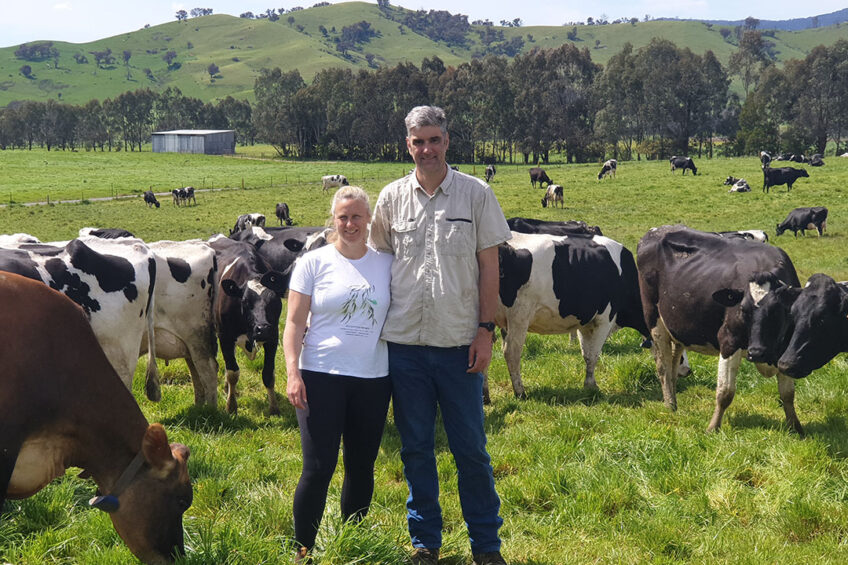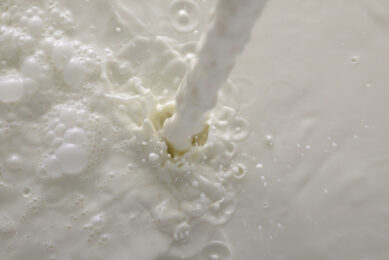Farm report, Australia: Adapting to a changing climate

Australian farmer Scott McKillop tries to adapt as well as possible to changing climate conditions in his region.
“That’s what we do as farmers,” he says. “We adapt and are always looking at what’s happening around us to make decisions.”
Whether it be for pasture allocation, what to feed or for making seasonal decisions based around planting, sowing or harvest of silage, Scott always checks multiple sources for seasonal and longer term climate forecasts.
Profile
Name: Scott McKillop and his wife Belinda and kids Angus Lexi and Marli operate a dairy farm near Dederang in the Australian state of Victoria.
The farm: They milk 380 cows off 200 hectares on a 500 hectare farm. They produce 3 million litres of milk a year. Scott’s family has been operating in the region for over 150 years.
Cooperative: He is one of the founding members of the new Mountain Milk Cooperative that was started a few years ago. “We are all very passionate about the great things that dairy offers,” he points out. “We have great care for our resources, such as our land, our animals and our people. We live in a beautiful part of the world and want to maintain that and prosper.”
He gets most of his weather information from Dairy Australia, CSIRO and the Bureau of Meteorology. “But we’re still looking for local knowledge,” Scott says. “We listen to the older generation that has a lot of experience. They have seen things in the past that can indicate change. Movement of animals for example, like ants or turtles.”
Seasonal weather patterns in north-east Victoria have changed, Scott emphasises. “There is less certainty. The patterns are more blurry. We don’t get the defined autumn, winter, spring and summer as we used to. You could always rely on a good spring in north-east Victoria and a good dry summer. Now we tend to be getting more variability in spring rain, drier winters and more humidity and rainfall events in summer.”

Scott has noticed more hot days, with temperatures rising above 35°C. “That obviously puts more pressure of heat loads on the cows,” he says. “But we also get more extremes of rain. We get large volumes of rain in short periods of time. Which can do damage to our tracks for example, on which we rely heavily to move our stock around on the farm.”
Tropical crops
Adapting means that Scott has to be flexible in making plans for his farm. “I understand that when I reach a certain point in time, and weather conditions haven’t materialised, I might have to move on to something else. When I get a combination of hot and wet weather forecast for the summer months, I grow tropical crops such as sorghum. That has become a bigger part of our forage system.”
Recently Scott has planted a brassica crop on a paddock, that was a bit neglected. “It was a difficult part of the farm with rocks and trees. We managed to sow there in early September and it’s flying out of the ground now. It will be a good quality feed for our youngstock in another 6 weeks time.”

Scott says he’s always looking 3 months ahead and tries to be proactive in his decision making. “This year, with the forecast being wet, we wanted to get the fertiliser on our land early, when it was dry enough to do so.”
Scott used a blend of nitrogen, sulphur, phosphorus and potassium to prepare for an early silage season. “We are harvesting silage at the moment, but it is becoming more difficult because of the rain,” Scott points out. “We’re in a great position. We have cut over 2000 tonnes of pit silage now. We’ve potentially got another 100 tonnes to go. By the end of the season, we’ll hope to have for about a year and a half of fodder supply on hand.”
An incredible growing season
Using the right fertiliser blend helps to keep the farm sustainable, says Scott. “We try to put back in what we cut out. If we continually keep our animals, plants and soil healthy, we keep our system in balance. And when we keep our pasture quality high, the cows maintain higher production for longer and we’ll have greater control over our costs and profitability. Cutting silage and harvesting grass is part of our pasture management.”
“Allowing pasture to get out of control on us, it will lose quality,” Scott says. “This leads to increasing fibre levels, and reductions in protein and energy, and milk production declines too. Plants keep their quality when they have good nutrients available to them. Later in the season, when things start to dry out, they maintain their quality for longer.”
We can grow more pasture across the season. And more crops. So we also look at climate change as an opportunity.”
This year has been an incredible growing season, he says. “We didn’t need to use our effluent water as much in autumn, because it just rained and rained. We did take our more solid stuff out and spread it across paddocks. We try to build the organic matter there and recycle our nutrients.”
Climate change can also bring positives, Scott has noticed. The slightly warmer and drier weather in the valleys where he lives enables him to grow more grass over a longer period in the year. “If we get a decent spring and some summer rainfall, we can grow more pasture across the season, as well as more crops. We also look at climate change as an opportunity.”
Activity collars for the dairy cows
The McKillops have invested in activity collars for the dairy cows, to get information on how the cows are impacted by extreme weather conditions, such as summer heatwaves. “They give us feedback on the cow’s activity every 10 minutes,” Scott says.

Scott downloads the information on his computer every morning and night. “It gives us information about eating times, their rumination and their activity. If there is any abnormal behaviour, I get an alert on my phone. With the data we have collected, we have been able to cut our feeding rate of grain back by 10% to 15% and maintained the fibre intake for longer into the season.”
To keep his cows cooler in summer and supply them with water, Scott has installed more sprinklers in the dairy yards. “You’ve got to have good water sources for them”, he says. “A Holstein Friesian cow will drink 150 or 160 litres a day when it’s really hot. We don’t let them walk too far and keep them close in those high temperatures. We do everything we can to make them comfortable because if we don’t look after them, they don’t look after us…”
Farm facts
Scott calves about 250 calves in the autumn, from March until the end of May, and 100 calves in the end of winter and in spring, from the middle of August until the end of September. The herd consists of Holstein Friesians.
“All our cows are AI bred,”Scott explains. “We have pretty big focus on genetic improvement. Recently we have been moving more towards using sexed semen in the milking herd as well as in heifers. We also try to create Angus Friesian cross animals for growers, that they can take to the market for beef.
About 300 hectares of the farm are used for youngstock and beef. “This year we have about 165 heifer calves due to the successful use of sexed semen from our partners at Alta Genetics. And next autumn we expect another 145 calves. The export market has been a good income earner for us,” Scott explains. “We are primarily a milk production business, but we also rely partly on this export, as a form of risk management. Our livestock sales of cull cows, export heifers and steers are another important form of income in its own right.”
Join 13,000+ subscribers
Subscribe to our newsletter to stay updated about all the need-to-know content in the dairy sector, two times a week.










